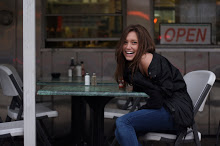
“Last time we met you told me that art is life, and life is art, and I see how that theory applied to the splatter paintings you showed me. I mean, I get it – life is messy and we have to remain focused even still, but what about that painting over there?”
“Which one?”
“The one that looks like some chopped up people with crazy eyes, some stick figures. Red, yellow, grey, see?”
“Oh, The Studio?”
“It’s a studio?”
“Yeah, the artist’s studio!”
“How do you know?”
“Let’s go over there for a moment… Okay, take a step back: what do you see here besides the crazy-eyed stick figures you mentioned before?”
“Triangles, rectangles? Shapes?”
“Okay, fair. Let me ask you a more specific question: The figure on the left—”
“Person!”
“Correct. Man or woman?”
“Woman.”
“Why?”
“Dress.”
“Great observation. Some say that it’s a model, standing in the artist’s studio waiting to be painted. But look carefully at the eyes of the figure. Do they look any different from the eyes of the figure on the right?”
“Well the lady on the left has three open eyes and the guy on the right only has two.”
“Correct! And because of that the figure on the left looks eerily alert and perceptive, right?”
“Yeah! Especially because she’s leaning forward.”
“You’re right, I hadn’t even noticed that detail! Scholars have suggested that Picasso’s many versions of his studio are his personal meditations, or exercises, on what to do when faced with a blank canvas. So here the artist might be painting himself in the process of grappling with that challenge.”
“So you’re saying that girl is Picasso? Actually, I can see that, and maybe that little diagonal line is his brush and the white rectangle is the canvas on which he is painting.”
“Exactly! You see this is a painting about dualities, like life which is a game of dualities!”
“You mean that there are always two ways of looking at it?”
“Right. Just as in life there are always a variety of ways to view a given situation, and there is never a single truth, so too is the case for this painting. In other words, every aspect of this painting is open to multiple interpretations, multiple readings.”
“As we discovered, the figure on the left can be viewed as a female model, or as the artist himself. It’s even possible that the big yellow rectangle behind the figure is the canvas onto which Picasso has already painted his perception of the model.”
“And how about Cyclopes over there on the left? Who’s he?”
“I wish I could give you a definitive answer, but that figure is mysterious to me too. I’d guess that it’s a sculpted bust, in other words a sculpture of a head that Picasso made and had sitting in his studio. Who do you think it could be?”
“Maybe it’s a reflection – no I guess not because the shapes of their faces aren’t the same.”
“Well, actually, you might be onto something. I know that Picasso often painted his own shadow into his paintings as a way of incorporating himself in his work, although this doesn’t really look like a shadow.”
“So maybe it actually is Picasso and he’s standing back looking at his work! Oh or maybe it’s Picasso’s angel – look it has a halo and it’s white!”
“I like all of those ideas and the fact that we can come up with this multiplicity of possible interpretations is precisely the point I was making about how this work relates to life.”
“Right, there are always multiples sides to every story and then sometimes things are just mysterious and we have to work to figure them out.”
“Exactly. And based on all of the interpretations we came up with it looks like Picasso understood this idea better than anyone. After all, here he seems to have depicted himself as the artist, the canvas, and the paintbrush – the creator, the created, and the tool necessary for creation.”
“That’s pretty cool.”
